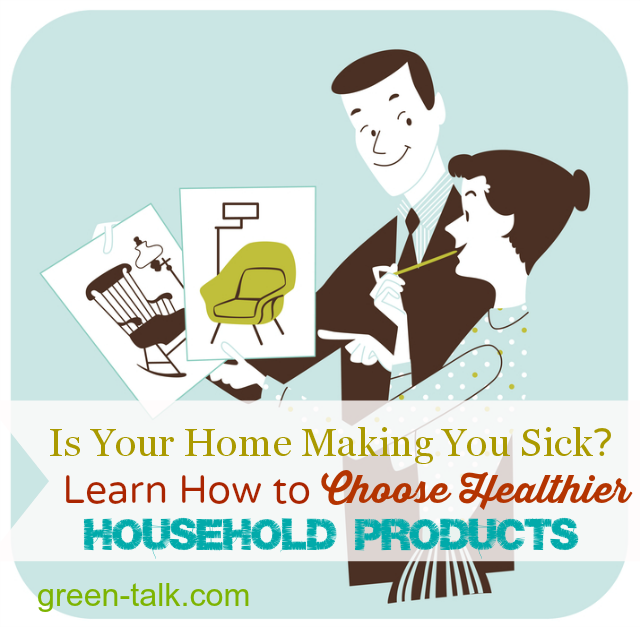During this Earth Day month, Green Sisterhood is focusing on a healthier Planet. I believe a healthier planet starts in the home. Reducing your exposure to volatile organic compounds swarming throughout your house is one of the first steps to a healthier house.
What are volatile organic compounds? They are carbon containing compounds that “evaporate easily from water into air at normal air temperatures.”
High VOC concentrations can cause eye and throat irritation, headaches, damage to the liver and nervous system as well as cancer. Indoor concentrations of VOCs can be much higher than outdoor concentrations– two to five times higher.
The following VOCs are off-gassed in common household products such as furniture, carpet, paints, adhesives, paint thinners, solvents, wood preservatives , cleaners and disinfectants, air fresheners, aerosol sprays, caulks, and fabrics:
- Acetone
- Benzene
- Ethylene glycol
- Formaldehyde
- Methylene chloride
- Perchloroethylene
- Toluene
- Xylene
- 1,3-butadiene
How Can You Reduce Your Exposure to These Chemicals?
1. Paints and Thinners: Look for products that are Green Seal certified especially for paints, paint thinners, and adhesives. See here for a list of approved products. If you are unable to find Green Seal certified products, opt for products that state they are “low odor.”
When using products such as paint thinners or aerosol sprays, make sure you open the windows or use them outdoors.
2. Wood Furniture: Opt for furniture that is made out of no added-formaldehyde-free wood and low VOC, water-based stains, finishes, and adhesives. Wood naturally contains formaldehyde.
A good starting point to find sustainable furniture is Sustainable Furnishing Council, but note, not all of the furniture companies listed are green. They are companies striving to be more sustainable.
Note: When you hear the term ” all wood,” particleboard, plywood and MDF (medium density fiberboard) are all wood but have glue in them to keep them together. So be careful when buying products that say they are all wood.
3. Cabinets: Cabinets are generally made of plywood, MDF, or particleboard. Opt for no added formaldehyde cabinets which have low VOC water based stains, finishes, and glues. Particleboard, MDF and plywood often contain added urea formaldehyde. However, in the past years, many manufacturers are producing no added formaldehyde products. See here for some particleboard and MDF products.
4. Fabrics: Fabrics can contain formaldehyde and other harmful chemicals. Here is a list of eco-friendly fabrics here and here.
5. Carpets: Carpet can emit VOCs. Opt for Green Label or Green Label Plus carpets. See a list here.
6. Trim: When creating paneling, be sure to follow the same guidelines as Wood Furniture. Most builders use particleboard or MDF.
7. Flooring: There are several choices in eco-friendly wood floors: FSC certified wood floors, Marmoleum, bamboo, cork, and recycle content tile. Some flooring contains adhesives with formaldehyde such as bamboo and floating cork floors. Look for Floor Score® certified products. See here for a list.
8. Aerosol Sprays and Cleaning Products: Many cleaning products and aerosols such as air fresheners contain harmful ingredients. EWG’s guide to cleaners focuses in my opinion, on indoor air quality. They have tested at least 2000 products. Note, if companies don’t disclose all of their ingredients, they received poor grades.
If you want to just make your own cleaning products, here is a list of some of my favorite DIY recipes.
I have only touched the tip of the iceberg about the chemicals toxicity in your household. Household products can also contain phthalates and flame retardants which can be detrimental to your health. So, do your homework before you bring products into your home.
This post was part of this week’s Green Sisterhood carnival on toxins. You can read my other green sisters articles here:
The Greening of Westford
ecokaren
The Soft Landing
Green 4 U
Jen and Joey Go Green
Almost All the Truth
Similar Posts:
- Green Nontoxic Remodeling Ideas for Common Home Upgrades
- Sierra Pine’s Medite II and Medex, Excellent Eco-Friendly Plywood Alternatives
- Terra Cabinets, A Socially Responsible Company where Greening Your Closets is a Priority
- Do You Get A Headache when You Walk into your Closet?
- Sleep On Latex: A Healthier Mattress to Sleep Better


lindsay says
Really great information Anna, excited to share. Love the graphic too!
Anna@Green Talk says
Lindsay, thanks. It is a topic dear to my heart. Anna
Small Footprints says
Thank you for these tips. We are getting ready to build a home … a small, Eco-friendly home. These tips will definitely come in handy!
Anna@Green Talk says
Small Footprint, best advice I can give to someone building a home is budget 20% over then you think. It always costs more. Green generally cost 15 to 20% more to begin with. Abba
Gretchen@HealthfulMama says
Because so many homes contain these materials, what would be your recommendation for those buying an older home (no control over materials)? Can we assume a level of safety from off-gassing over the years or no?
Anna@Green Talk says
Gretchen, I think for the most part you can be safe from VOC off-gassing with older homes but they also come with a host of problems too. There might be asbestos, lead, and formaldehyde in the insulation.
Formaldehyde take awhile to offgas completely. I don’t know how it offgases in insulation. I have been trying for years to get a good answer about formaldehyde off-gassing. Anna